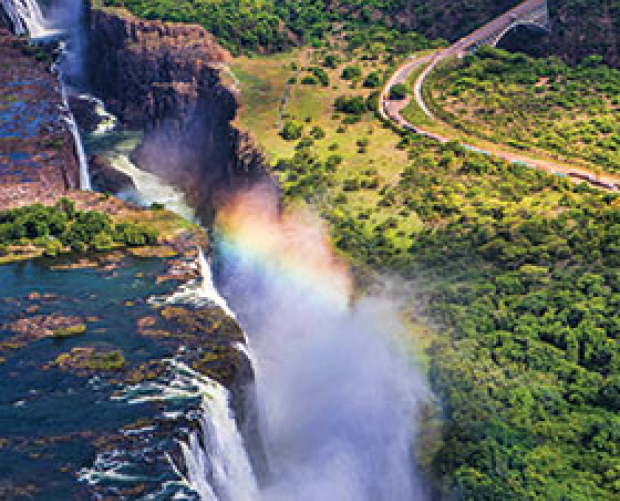

Africa’s national parks and game reserves provide sanctuary to a diverse array of wildlife. Within their boundaries, a diverse and abundant animal kingdom thrives. Experience first-hand, facing life and death as predators track their prey across the savannah. Witness the natural beauty of vast grasslands, mountain rainforests, lush waterways and dusty bushveld.
By visiting the national parks in Africa, you will be supporting the conservation of some of the world’s most precious flora and fauna.
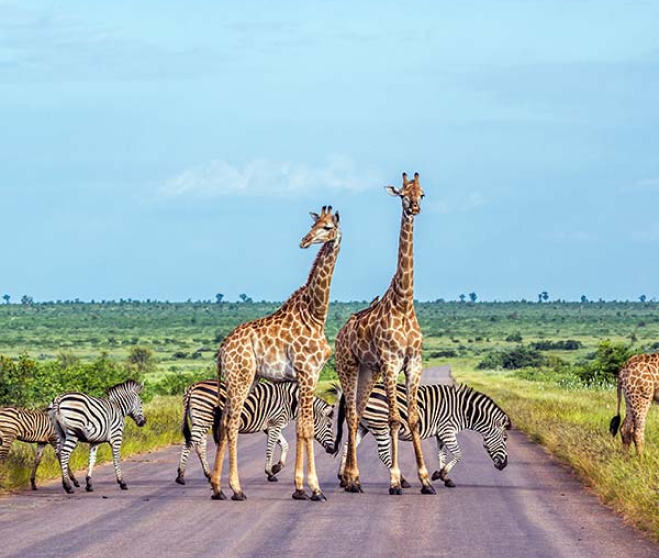
Ngorongoro is one of the world’s most stunning natural wonders, encompassing an area of approximately 260 square kilometres. Swampy wetlands, open savannah, woodlands and a lake are all set within steep, forest-clad walls. The walls themselves climb 610 metres to the crater’s rim. The crater has become a natural habitat for a diverse range of wildlife. You can encounter flamingos, hippos, black rhinos, Cape buffalo, zebra, eland and warthogs. These magnificent animals graze the plains, watched eagerly by predators such as lions, cheetahs, leopards and scavenging hyenas. All can be easily spotted and photographed. The Maasai people, easily visible in their traditional scarlet robes, can also be seen guiding their cattle down the steep crater walls.
Best Time To Visit:
The Ngorongoro Crater is a fantastic year-round destination. However, if you want to escape the crowds, head out around April-May during the rainy season.
Victoria Falls, part of the Mosi-oa-Tunya National Park, is one of the seven natural wonders of the world. The falls are the widest sheet of falling water on earth. They have UNESCO World Heritage Site status. With falls cascading along its 1.7 kilometre length, it’s hard to imagine its grandeur. You really have to see it to believe it. Be prepared to get wet with adrenaline-pumping adventure options. Rafting, bungy jumping and canoe trips can be organised locally (seasonal).
Best Time To Visit:
The falls are at their most spectacular from February to April, when the Zambezi River is at its most powerful. It can be more difficult to photograph in the wet season of May to June. Rafting and swimming in Devil’s Armchair are safest when the river recedes around July through to December.
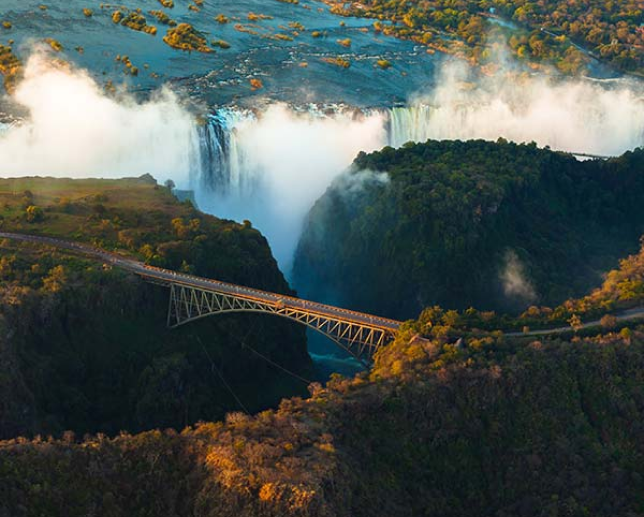
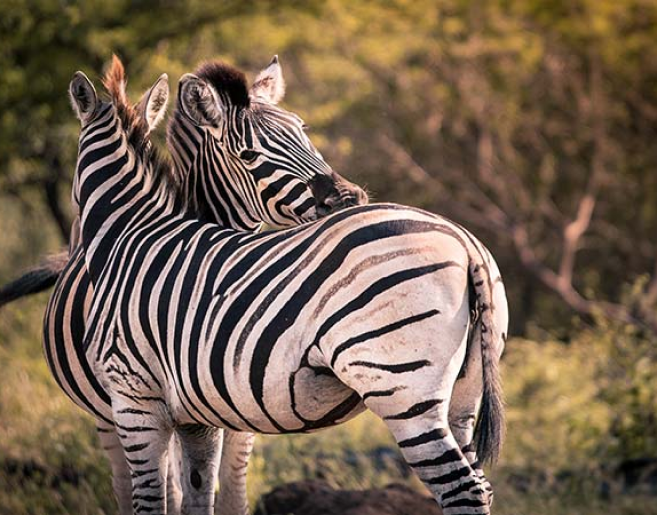
The world-renowned Kruger National Park (also known simply as The Kruger) offers an experience that ranks among the best in Africa. Among the 1,982 types of plants and trees are 34 types of amphibians and 114 of reptiles. Not to mention (though we will) the 507 species of birds and 147 species of mammals. The Big Five are well represented, with around 1,500 lions, 12,000 elephants, 2,500 Cape buffalos, 1,000 leopards and 5,000 rhinos (black and white) roaming the park. Hippopotami, giraffes, zebras, various antelope species and endangered wild dogs can also be seen.
Best Time To Visit:
Winter, from May through September, provides great wildlife watching with low grass, bare bushes and trees and wildlife congregating around watering holes. The spring brings newborn animals, and the summer brings lush vegetation.
The Addo Elephant National Park stands as a true conservation success story. In 1931, when the park was inaugurated, only eleven elephants remained. Today, the 164,000-hectare sanctuary is home to 450 elephants as well as about 48 endangered black rhinos, Cape buffalo, a variety of antelope species, and the unique flightless dung beetle, which is found almost exclusively in Addo. The park is also famous for having the largest coastal dune field in the southern hemisphere.
Best Time To Visit:
During the dry winter season of June to August there is less rainfall, more animals near watering holes and the shorter grass makes wildlife easier to spot.
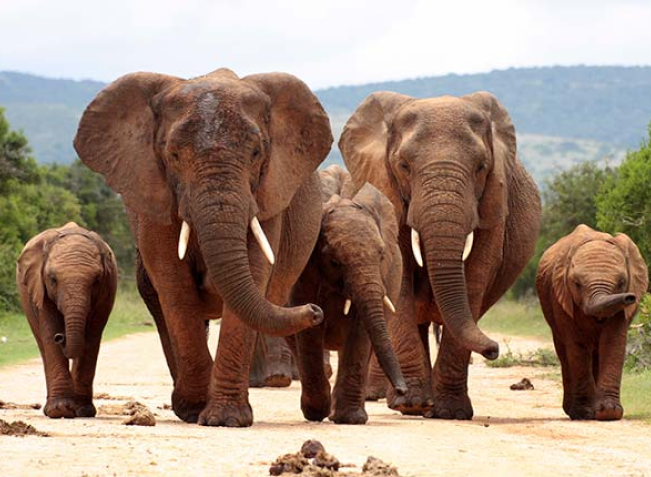
We can recommend numerous tours which visit various National Parks all over Africa. G Adventure offer an amazing range of tours, including these National Geographic Tours and Jane Goodall Wildlife Tours.
Click on the link here or below to see a range of alternative offers.
If none of that takes your fancy, make an enquiry with our Tailor-made specialists and build an itinerary of your own!
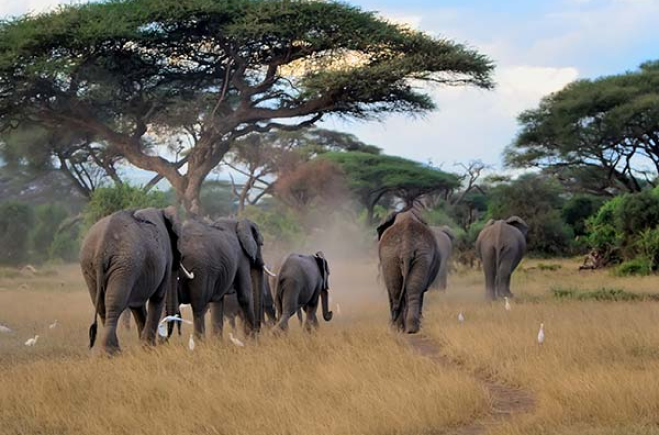
Renowned for its huge elephant population, Chobe National Park has an estimated 70,000 to 120,000 elephants roaming across its 11,000 square kilometre area. The park offers extreme contrasts in terms of landscape and vegetation, which varies from almost tropical swamplands to severe desert-like spaces, vast grasslands to sandy woodlands and Acacia scrub. Take a safari into the pristine wilderness and watch the world’s largest land animals move across the plains.
Best Time To Visit:
Chobe National Park has great wildlife viewing all year round but the best time to visit is the drier, cooler winter months from June to October.
The Okavango Delta is a network of waterways, lagoons, swamps and wooded islands fed by the Okavango River. Ranging over 15,000 square kilometres, the wetlands sustain a diverse array of wildlife as the water fans out to empty into the dry yellow sands of the Kalahari Desert. The best way to explore this natural wonder is by mokoro, a shallow boat fashioned from a single tree trunk. There is plenty of wildlife to see, with tens of thousands of elephants, several thousand hippos, aquatic antelope species and migratory birds inhabiting the delta.
Best Time To Visit:
The best game viewing occurs in the drier period of May to October, but for lush vegetation and bird populations, visit in November to April.
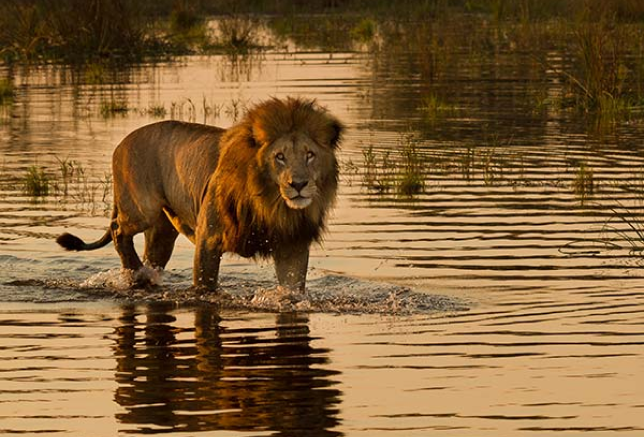

The keen rival of the Masai Mara, the Serengeti is renowned as being one of the best national parks in Africa. 15,000 sq km of arid plains and swaying savannahs, interspersed with acacia trees make up this classic example of a safari experience. With such a large area, game drives will often feel like you have the entire park to yourself. This is the perfect spot for ticking off the big 5, especially as it is home to the largest lion population in the world. One of the biggest highlights of visiting the Serengeti is experiencing The Great Migration during December – July where millions of zebra, wildebeest and gazelle roam the lands migrating to the greener Masai Mara, predators silently following behind.
Best Time To Visit:
The Serengeti is an all year destination however if you want to witness the Great Migration, it reaches the Mara River around July – August.
Etosha, meaning “great white place” was declared a national park in 1907 and covers an area of 22,270 square kilometres in the far north of Namibia. The park is dominated by a massive mineral pan which covers about 25% of the park and provides a silver-white backdrop to an area of semi-arid savannah grassland and thorn scrub. The reserve is home to some 114 mammal species, 340 bird species, 110 reptile species, 16 amphibian species and surprisingly, one species of fish. Most visitors will see many antelope species, elephant, giraffe, rhino and lions and a few visitors may see the elusive leopard, black rhinos and cheetahs. Many of the park’s water holes are floodlit at night, offering visitors the chance to see a lot of game in once place.
Best Time To Visit:
You’ll find it easier to spot larger concentrations of animals during the dry season from May to September when animals congregate around the water holes.
View tours to Etosha National Park
Click here to read more about Wildlife Spotting with Tucan Travel.
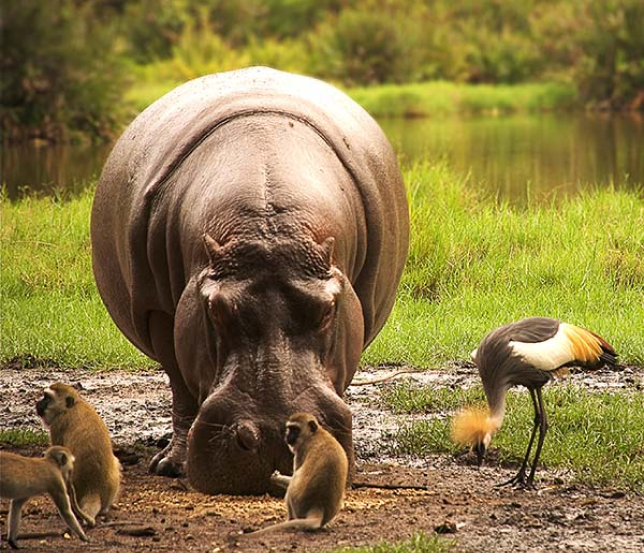
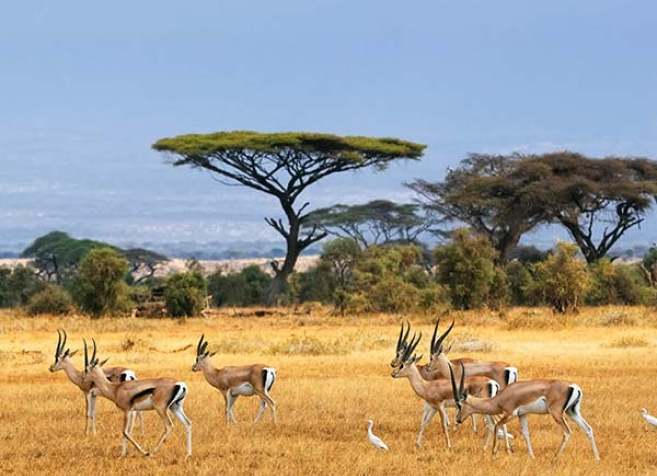
Often referred to and widely known as the greatest game reserve in the world, the Masai Mara provides the quintessential African safari experience. It’s like stepping onto the set of the Lion King. The biggest highlight of visiting the Masai Mara is to fall witness to The Great Migration. Millions of wildebeest, gazelle and zebra migrate to the Serengeti plains during July – October in a swarming stampede, with predators such as lions, cheetahs, jackals and leopards following closely behind. Dry savannahs transverse as far as the eye can see, whilst hippos and crocodiles bathe in the low rivers. The raw, wild beauty at the Masai Mara can impress even the most avid of safari-goers and is well-known as one of the top things to do in Africa.
Best Time To Visit:
In general, the best months for game viewing in Kenya are June – October. If you want to witness the Great Migration, it reaches the Mara River around July – August.
One of life’s greatest wildlife experiences is tracking Gorillas at Bwindi Impenetrable Forest. Impressively, this UNESCO World Heritage Site is home to nearly half the world’s population of mountain gorillas. Trek through one of the most biologically diverse areas in the world, passing through lush, mountain rainforest, serene streams and breathtaking viewpoints. Bwindi Impenetrable National Park is home to the most mammal species in Uganda where as well as tracking gorillas you can also see forest elephants, bushbucks, giant forest hogs, duikers, African golden cats and 11 other species of primate.
Best Time To Visit:
Best time to visit: Bwindi Impenetrable Forest is open all year round however there is less rain between June – August and December to February making hiking much easier on the trails.
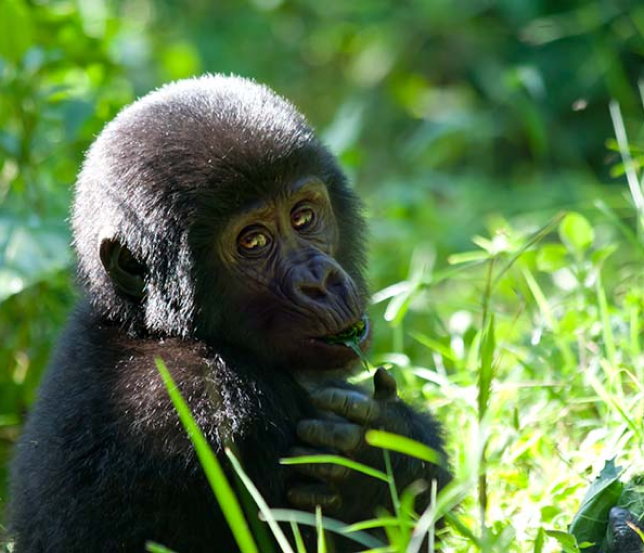
We would like to live in a world where our adventure experience is open to everyone.
Doing nothing isn’t an option. So, we act with purpose to do what we can where we are. We trust all Tucan travellers to do the same.
Click on the link here to read more about our commitment to responsible travel.
We are passionate adventure travelers who want to share the world and our travel experiences with everyone…
This website uses cookies so that we can provide you with the best user experience possible. Cookie information is stored in your browser and performs functions such as recognising you when you return to our website and helping our team to understand which sections of the website you find most interesting and useful.
Strictly Necessary Cookie should be enabled at all times so that we can save your preferences for cookie settings.
If you disable this cookie, we will not be able to save your preferences. This means that every time you visit this website you will need to enable or disable cookies again.
